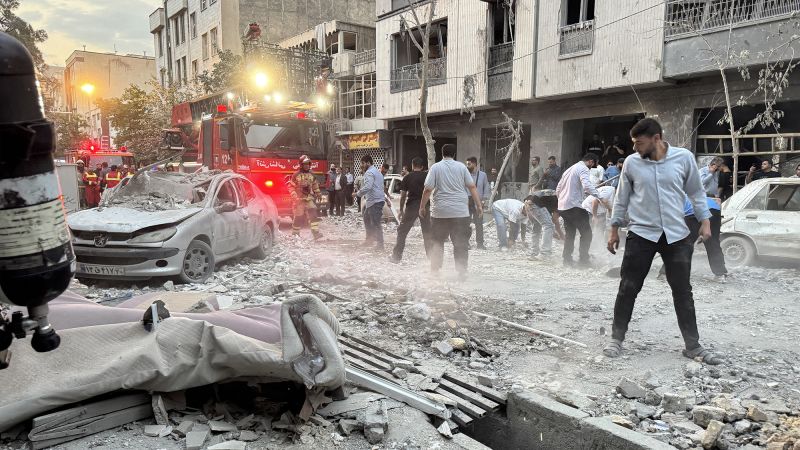CNN
—
Shortly before sunrise in Iran on Friday, Israel launched the first strikes of its operation against the regime’s nuclear program.
That operation, called “Rising Lion,” had two prongs: Heavy airstrikes against at least one of Iran’s enrichment sites, and more targeted strikes in Tehran to decapitate the regime’s military leadership. It aimed to halt what Israel said was Tehran’s rapid progress in developing nuclear weapons.
Israel’s attack came after years of threats and days of heightened speculation – but without the United States’ blessing. The Trump administration stressed that Israel acted unilaterally and that Washington was “not involved.”
Israeli Prime Minister Benjamin Netanyahu said the operation would continue “for as many days as it takes” to eliminate Iran’s nuclear threat. Tehran, which insists its nuclear program is peaceful, says it has “no option but to respond.”
Here’s what you need to know.
Where and when did Israel strike?
The first explosions tore through Tehran at around 3.30 a.m. Friday (8 p.m. ET Thursday). Videos geolocated by CNN showed flames and smoke billowing from buildings across the city.
Residents of Tehran were blindsided. Many did not expect Israel to strike so swiftly. “I didn’t know what was happening. It was really scary,” a 17-year-old Iranian told CNN, requesting anonymity due to safety concerns.
Shortly after explosions rocked Tehran, Israel also struck elsewhere in the country. Israel’s military said it used jets to strike “dozens of military targets, including nuclear targets in different areas of Iran.”
An explosion was reported at Iran’s main enrichment facility in Natanz, about 250 kilometers (150 miles) south of Tehran.
The United Nations’ nuclear watchdog, the International Atomic Energy Agency (IAEA), confirmed that Natanz had been hit, but said it had not observed an increase in radiation levels in the area.
Rafael Grossi, the head of the IAEA, said other nuclear facilities in Iran – Isfahan, Bushehr and Fordow – were not impacted. The Fordow site is buried under a mountain, and is considered a much harder target for Israel.
In a televised address, Netanyahu said Israel had taken action to “roll back the Iranian threat to Israel’s very survival,” and said it would continue its operation for as long as it takes “to remove these threats.”
Netanyahu claimed that Iran had in recent years produced enough highly enriched uranium for nine nuclear weapons.
“Iran could produce a nuclear weapon in a very short time. It could be a year, it could be within a few months,” he said. “This is a clear and present danger to Israel’s survival.”
The Israel Defense Forces (IDF) also said it had destroyed Iran’s ballistic missile launch sites and stockpiles.
Several of the most important men in Iran’s military and its nuclear program were killed in Israel’s strikes.
Maj. Gen. Hossein Salami, head of the secretive Islamic Revolutionary Guard Corps (IRGC), was the highest-profile of those killed.
Israel also said it killed Maj. Gen. Mohammad Bagheri, chief of staff of Iran’s armed forces; Ali Shamkhani, a close aide to Iran’s Supreme Leader Ayatollah Ali Khamenei; and Ali Hajizadeh, commander of the IRGC’s air force.
Iran’s retaliation has already begun. The IDF said Tehran has fired more than 100 drones toward Israel and that Israeli defenses were working to intercept the drones.
Iran’s President Masoud Pezeshkian urged the Iranian people to remain unified and trust Iran’s leadership.
“The nation needs unity… more than ever,” he added.
After a series of lethal and embarrassing Israeli blows against the Iranian regime, it is not clear how Tehran might attempt to exact retribution.
Following previous Israeli attacks against Iran and its proxies in the region, Tehran fired back with huge salvos of ballistic missiles.
The Institute for the Study of War, a think tank in Washington DC, said this time it was “possible that Israel somehow disrupted Iran’s response by targeting Iran’s ballistic missile launch sites and stockpiles.”
The Trump administration – which has been pursuing a diplomatic path with Iran in recent weeks – sought to distance itself from Israel’s attack.
Secretary of State Marco Rubio said Israel’s actions were “unilateral.” Although Israel notified the US ahead of its strikes, Rubio said the US was “not involved” in the attack.
“Our top priority is protecting American forces in the region,” he added. Earlier this week, the US had made efforts to arrange the departure of non-essential personnel from various countries in the Middle East, leading to speculation that an Israeli attack on Iran could be imminent.
US President Donald Trump urged Iran to agree to a new nuclear deal “before there is nothing left,” suggesting that follow-up Israeli attacks on the country would be “even more brutal.”
Trump said he had given Iran “chance after chance” to make a deal. “JUST DO IT, BEFORE IT IS TOO LATE,” he wrote on Truth Social, his social media platform.
Under a 2015 nuclear deal struck by former US President Barack Obama, formally known as the Joint Comprehensive Plan of Action (JCPOA), Iran agreed to drastically limit its number of centrifuges and cap uranium enrichment at levels far below those required to make weapons, in exchange for sanctions relief.
But during his first term as president in 2018, Trump withdrew from the JCPOA, saying the “rotten structure” of the agreement was not enough to prevent Iran from developing a nuclear bomb. He ramped up sanctions on Iran and threatened to sanction any country that helped the regime to obtain nuclear weapons.
In his second term, Trump has revived efforts to strike a new nuclear deal with Iran. Just hours before Israel’s strikes, the president cautioned Israel against launching an attack while US-Iran talks are ongoing.
“As long as I think there is an agreement, I don’t want them going in because that would blow it. Might help it, actually, but also could blow it,” Trump said.

